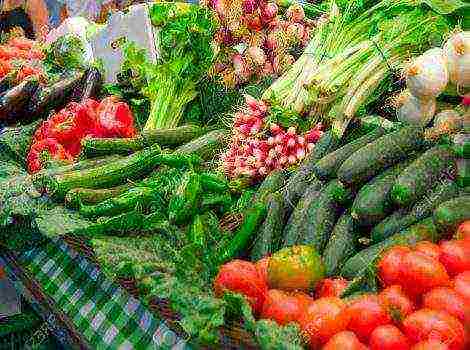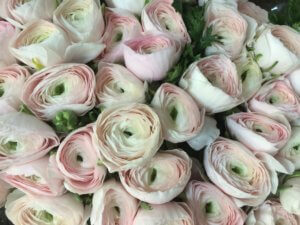Content [show]
Table grape varieties - varieties intended for fresh consumption.
On this page I will publish descriptions, photos and videos of table grape varieties growing and bearing fruit in my area (Belarus, Gomel). All varieties grow in open ground, ripen well and gain varietal flavor and dimensional characteristics. You can learn more about the description of the variety you like by clicking on its name or link "Read more ..."
Before proceeding to the choice of grape varieties, I strongly recommend that you study this article "How to choose the right grape variety.»This will give you the opportunity to approach the choice consciously and avoid many mistakes and disappointments in the future.
Arcadia
For many decades this remarkable form has been an irreplaceable leader in the ratings of grape varieties in terms of the aggregate of positive characteristics. Yes, there are tastier varieties, there are more productive ones, there are more frost-resistant and less painful ones, but if you add all the characteristics together and consider exactly the totality of all the negative and positive features of a particular variety, it turns out that there has been no alternative to Arcadia for many years. It is for this reason that this variety can undoubtedly be called the most popular grape variety in the post-Soviet space."Read more ..."
Codryanka (or "Black magic" Black magic)
The large-fruited table grape variety "Codryanka" was bred by the specialists of the Moldavian Research Institute of Life Sciences "Vierul" from the well-known varieties "Moldova" and "Marshalsky".After the Italians acquired a patent for this variety, the variety changed its name to Black magic, but for us it will forever remain under the well-known and beloved name - Codryanka. A very early ripening variety, from the beginning of the growing season to the technical maturity of the grapes, the variety needs 110-120 days. "Read more ..."
Gorgeous
This delicious and undoubtedly one of the most beautiful grape varieties was bred by the famous amateur breeder E.G. Pavlovsky. The variety is created on the basis of the pink-fruited Victoria variety with the addition of pollen from the European-Amur forms of grapes. The Krasotka variety is a large-fruited form of early ripening table grapes. From the beginning of the growing season to the ripening of the harvest, the variety needs only 110-115 days, which makes it suitable for cultivation in regions that are not traditional for viticulture. The growth vigor of the bush is average, the vine ripens well. In the northern regions of cultivation, it requires shelter for the winter."Read more ..."
Kishmish No. 342 (Hungarian complex)
Kishmish No. 342 or Hungarian kishmish is a hybrid form of grapes of a very early ripening period. From the beginning of the growing season to the full maturity of the grapes, the variety needs only 105-110 days. In me, in Belarus (Gomel), the variety ripens the very first in mid-August, 1-2 weeks earlier than other varieties.
This hybrid form of grapes was developed in Hungary through selection work with varieties such as Villard Blanc and Perlet."Read more ..."
Kishmish Radiant
This variety is undoubtedly one of the best achievements of viticulture in breeding seedless varieties. Huge yield, taste, aesthetics and marketability of the berry make this variety one of the best raisins for growing in commercial and amateur vineyards.
Disease resistance and low frost resistance complicate the cultivation technique, but all other characteristics, and especially the taste of the berry and the aesthetics of the bunch, allow this variety to occupy a leading position in the market of seedless grape varieties."Read more ..."
Libya
The large-fruited table grape variety Libya, without a doubt, can be attributed to one of the best varieties of modern grape selection. The author of the variety is one of the most famous amateur breeders - Zagorulko V.V. (Zaporozhye, Ukraine).
In 2010, the copyright for the then hybrid form "Libya" was transferred to the All-Russian National Research Institute of Viticulture and Winemaking "Magarach" (Crimea), where a few years later this wonderful form received a high grade title and entered the state register of varieties Ukraine. "Read more ..."
Nadezhda AZOS
Today we will consider the prospects of growing in our northern latitudes one of the "elders" in the black-fruited segment of viticulture - the variety Nadezhda Azos (Anapa Zonal Experimental Station of Viticulture and Winemaking). This variety is already more than 40 years old, but it can be safely ranked among the classics of modern viticulture, along with Arcadia, Laura, Kodryanka, Radiant, etc.
"Old" - many dismiss.
Perhaps ... only for some reason this "old" does not leave and is unlikely to leave our vineyards, unlike hundreds of amateur novelties that loudly declared themselves and, having ripped off the "cash register" for the sale of seedlings, removed in disgrace after 2-3 years of cultivation. "Read more ..."
Flora (Laura)
The grape variety "Flora", and this is how the form of grapes "Laura", which has long been known and beloved by many winegrowers, has been entered into the State Register of Varieties of Ukraine, is a great success of the Odessa Institute of Viticulture and Winemaking. V.E. Tairov National Academy of Sciences of Ukraine. By crossing the varieties "Muscat de Saint-Valier", "Husaine", a mixture of pollen "Muscat of Hamburg" and "Queen of Tairovskaya", scientists managed to obtain a grape form that is truly excellent in its taste and varietal characteristics."Read more ..."
Transformation
Transfiguration is a large-fruited form of early ripening grapes (110-115 days) with truly amazing dimensional characteristics of the bunch as a whole and the berry separately. At the moment, the assignment of this hybrid form of grapes to the status of a variety is being considered. The bunch has a conical or cylindrical shape and medium density, and the berry is elongated-oval. With good cultivation techniques, bunches can reach gigantic sizes and weigh more than 3 kg. with an average weight of a bunch of 1-1.5 kg. At the same time, the average weight of berries is 13-14 grams, and individual berries in a bunch have dimensions commensurate with a matchbox and a weight of 20 grams."Read more ..."
Anniversary of Novocherkassk
Anniversary of Novocherkassk - one of three hybrid forms of grapes of the famous "Troika Krainov" ("Anniversary of Novocherkassk", "Transformation", "Victor"). These forms have made a splash in the grape market. The aesthetics and dimensional characteristics of both the bunch in general and the berries in particular, allowed this grape to gain a leading position in the commercial vineyards of winegrowers in Ukraine and southern Russia in the rose segment.
"Read more ..."
Belarus is not the most suitable place for growing such heat-loving grapes. But the constant work of breeders to develop new varieties that are resistant to unfavorable weather conditions made the cultivation of this crop on the Belarusian land quite real and affordable even for gardeners who have no special experience.
History of grape cultivation in Belarus
The first written mention of the cultivation of grapes in Belarus dates back to the 11th century. Since that time, the order on the shelter of the vines for the winter, given by the bishop to the hegumen of the Turov monastery, has been preserved. In the 18th century, grapes became a fairly popular greenhouse and park culture. It is reliably known about its cultivation in the estate of the Radziwills "Alba", located near the town of Nesvizh, and other estates of noble people.
Belarusian viticulture reached a higher level of development in 1840, when an agricultural school was founded on the Gory-Gorki estate of the Mogilev province. The head of the fruit nursery created on its basis collected a large collection of plants, which included 6 varieties of grapes.
An experienced gardener Iosif Kondratyevich Moroz played a significant role in the distribution of grapes in Belarus. On a rented estate near the village of Fatyn, he has been growing this crop since 1900. IK Moroz gave particular preference to the early Malenger variety.

Malenger early can be found in the vineyards of Belarus today
After the revolution, the Academy of Sciences of Belarus took up the study of viticulture in the country. Grapes were also planted on the collective farms of the Gomel region. Only in the Khoininsky district, this culture occupied about 6 hectares. Unfortunately, most of the vineyards were destroyed during the Great Patriotic War.
After the end of the war, a large number of strong points were opened, which were engaged in testing grape varieties in the conditions of Belarus. Such famous breeders as I.M. Kisel and I.P. Sykora. During these years, the Belarusian viticulture reached its peak. Both large farms and amateur gardeners were engaged in it. The All-Union census of fruit and berry plantations, carried out in 1953, counted 90 195 grape bushes.
But conducted in 1954-1964 by the Institute of Biology of the Academy of Sciences of Belarus showed that most varieties planted in the vineyards of the republic are not suitable for growing in these climatic conditions and even in the southernmost regions ripen no more than 6-8 times every ten years. Lack of economic feasibility led to the gradual abandonment of farms from growing grapes... As a result, by 1965 small vineyards remained in only a few districts of the Brest region.
The second wind of the Belarusian viticulture opened in the 80s of the last century.The development of new grape varieties that tolerate difficult climatic conditions made it possible to grow it in all areas of the region. Great interest in this culture continues to this day. Today it can be found in many garden plots of the country.
Video: republican exhibition of grapes in the city of Pinsk
How to choose a grape variety for growing in Belarus
The weather conditions in Belarus are not very suitable for classic grape varieties. Here they often suffer from frost in winter and high humidity in the warm season. In addition, many of them do not have time to mature in a rather short summer by southern standards with a few hot days. Grapes and swampy soils, with a high level of groundwater and a high content of peat, which occupy most of the country's territory, do not benefit.
There are advantages in northern viticulture. In Belarus, phylloxera (grape aphid), which has become a real scourge of southern vineyards, phomopsis (black spot) and viral infections are almost completely absent. For a long time, Belarusian winegrowers rarely encountered fungal diseases. But in recent years, due to the active import of southern seedlings into the country and global climate change, cases of infection of grapes with mildew, oidium and anthracnose have become much more common. But all the same, the level of spread of these infections is much lower than in the south.
In order to succeed in growing grapes, experienced gardeners are advised to choose varieties that meet the following criteria:
- winter hardiness;
- early and super-early ripening;
- the ability to ripen when the sum of active temperatures is below 2,600 ° for the southern regions and less than 2,400 ° for the north;
- quick recovery of the vine after damage caused by low temperatures;
- the presence of immunity to fungal infections.
Video: Belarusian winegrower talks about the intricacies of the selection of varieties
Varieties of Belarusian selection
The scientific study of grapes and their selection on the territory of Belarus is carried out by the RUE “Institute of Fruit Growing”. Thanks to the work of its specialists, several grape varieties were born that grow well in the climatic conditions of Belarus and are included in the State Register of Breeding Achievements of that country. These include:
- Minsk pink. A vigorous, versatile grape with a very early ripening period. Small, weighing about 2.2 grams, berries of this variety are painted in a dark pink color and have a juicy flesh of a slimy consistency with a labrus flavor. The skin is thin, fragile. In the conditions of the Vitebsk region, it ripens in early September. Minsk pink tolerates temperatures as low as -29 ° C and is resistant to most fungal infections.
An excellent variety. You don't need to cover, cut it to a meter height, bent it down, and that's it! Ripens in August-September completely, sweet, it came to wine only once, and we constantly eat it.
- Cosmos (Neptune). A versatile variety with high vigor and good maturation of the vine. Its black small berries with fleshy, juicy, tart pulp are collected in loose clusters weighing about 120 grams. They usually ripen in late August and early September. About 2, 1 kg of fruits are harvested from one bush. Winter hardiness of the variety - up to -26 ° C. Space rarely suffers from mildew and gray rot, but it can be affected by powdery mildew.
- Astronaut. Table grape variety, ripening 101 days after the start of the growing season). The berries are dark purple, small with a simple sweet taste. Their pulp contains about 18.4% sugars with an acidity of 4.8 g / L. The tasting score of berries is 7.9 points out of 10. The astronaut is often affected by fungal infections, and its frost resistance does not exceed -24 ° C. The yield of the variety is about 2 , 4 kg per plant.
- The beauty of the north (Olga). High-yielding (about 4.1 kg per plant) table grape variety. The berries are large, weighing up to 5 g, colored light green.The pulp is fleshy-juicy, sweet, with a tart or slightly grassy aftertaste. The beauty of the north often suffers from fungal infections. Average frost resistance of the variety is about -26 ° C.
For me, the variety is tasty, but ... and very problematic - oidium. I don't use chemical protection at all - that's the shortage of the crop.
The varieties Kosmos, Cosmonaut, Krasa Severa were created in cooperation with specialists from the All-Russian Research Institute of Genetics and Breeding of Fruit Plants named after I.V. Michurin.
Photo gallery: grape varieties bred by specialists of the Institute of Fruit Growing
Non-covering varieties
Grapes are a thermophilic culture. In the conditions of Belarus, he needs shelter for the winter. Only some varieties, the winter hardiness of which exceeds -28 ° C, can endure the cold season without it. For example:
- Minsk pink;
- Lepsna;
- Alpha;
- Somerset Siddles;
- Sharov's riddle;
- Marshal Foch.
Lepsna
A universal grape variety of Lithuanian selection. Easily tolerates air temperatures below - 28-30 ° C. In addition, this variety is highly resistant to mildew and gray rot, and medium - to powdery mildew.
Lepsna bushes are vigorous, ripening well along their entire length. Berries are dark red, weighing 3-4 grams, form small cylindrical clusters of medium density. The pulp is fleshy-juicy, harmonious taste with a light labrusca aroma. It contains up to 19% sugars with an acidity of about 5 g / l.
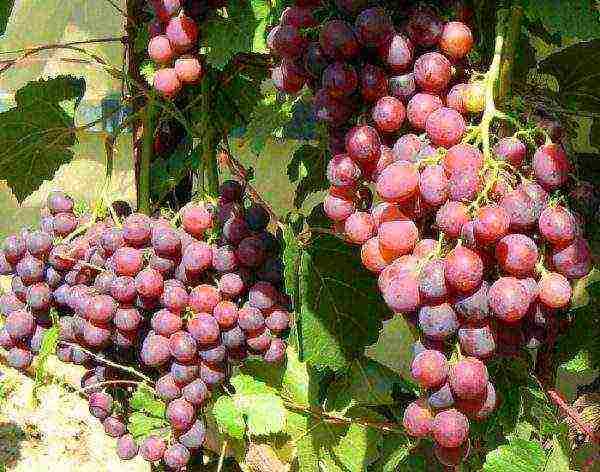
Lepsna berries tolerate transportation and storage well.
In the conditions of Belarus, Lepsna ripens 100–110 days after the leaves bloom. Its berries are eaten fresh and used to make juices, wines and compotes.
Somerset Siddles
Seedless grape variety originated in the United States of America. Possesses unique winter hardiness. According to various sources, it ranges from -30 to -34 ° C.
Somerset Sidlis vine has medium vigor. The berries are light pink in color with a very juicy and sweet pulp with a delicate strawberry flavor. They ripen within 110-115 days after the beginning of the growing season. Rudiments of seeds in berries are quite rare.

Somerset Seedlis is a very hardy, seedless grape variety
Somerset Seedlis is immune to most fungal diseases, but often suffers from attacks by wasps attracted by its sweet and aromatic berries. The yield of the variety is average.
In my conditions, one of the few who survived the rehearsal of nature without tangible losses, loaded with fruitful shoots, pleases. Last season, no rudiments were found when eating. A good replacement for the ubiquitous growing in our places Alpha.
Marshal Foch
A technical grape variety belonging to the group of Franco-American hybrids. Easily withstands frosts down to -29 ° C, and according to some reports, even up to -32 ° C. Marshal Foch is included in the State Register of Varieties of the Republic of Belarus.
The vines of this variety are characterized by medium vigor. The berries are round, small, dark blue. They produce high-quality rosé and red table wines with good coloration.
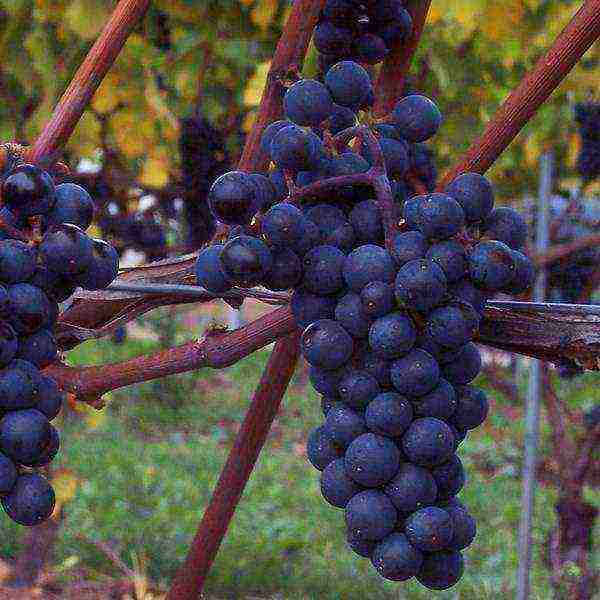
The Marshal Foch grape variety was named after the head of the French Armed Forces during World War I, Ferdinand Foch.
Marshal Foch is resistant to mildew and powdery mildew. The yield of the variety is average. To increase it, experienced growers practice overloading the bush with eyes, followed by a fragment of infertile shoots.
The wine was made. It turned out almost 5 liters. Yesterday we made a test tasting with family. So dark, thick, rich! For me, a beginner and loved ones, just awesome. Urgently, the remaining 4 liters, I corked and put in the cellar for storage. At least until spring. This year the wine from MF is the best! This is a preliminary estimate.
Early
Early grape varieties are especially popular with Belarusian gardeners. For ripening, 95 -125 days are enough for them with the sum of active temperatures not exceeding 2,600 ° C. This allows you to collect a bountiful harvest of grapes even in the short Belarusian summer.The earliest ripening period in Belarus is possessed by the following varieties of this culture:
- Alyoshenkin;
- Don Agate;
- Northern early;
- Purple August;
- Russian corinka;
- Tukay;
- Crystal;
- Tason.
Agate donskoy
Table grape variety bred by specialists of the VNIIViV named after Ya. Potapenko (city of Novocherkassk). Its berries ripen 115–120 days after leafing out at a sum of active temperatures of 2,450 ° C.
Don agate is a vigorous variety with dark blue berries weighing up to 5 grams. The pulp is fleshy, with a simple taste without a pronounced aroma, the skin is dense, easily eaten. The variety is very high-yielding and tends to be overloaded with berries, therefore it needs mandatory normalization. During it, 1-2 clusters are left on one shoot. Failure to comply with this rule can lead to an increase in the ripening period and a deterioration in the taste of the berries.
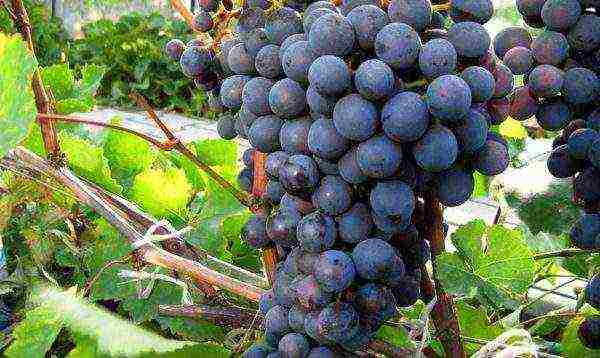
Agat Donskoy enjoys well-deserved popularity among winegrowers in Belarus
Don agate has increased resistance to mildew, gray rot and low temperatures (down to -26 ° C). Due to its unpretentiousness and good taste, this variety has become widespread in Belarus. Experienced gardeners often recommend it for growing to newcomers new to viticulture.
And Agat Donskoy last year, only one and pleased me, the rest of the varieties are either frost or rains during flowering, and this one is at least henna. ripening of the vine is good for almost the entire growth of 2.5–3 meters. The taste of berries is more like neutral, but it does not bore you, you can eat a lot, and if you make a compote from it, it turns out very tasty, I don’t understand why its wasps love it very much next to it, I have Kiev white, so it is sugary from sugar, but wasps it is not eaten, but for agate as for honey. This year I planted two more seedlings, it will be like a workhorse.
Russian corinka
Russian Korinka is one of the earliest grape varieties. Even in the northern regions of Belarus, it is ready to harvest in the second or third decade of August.
The berries of Korinka Russian are small, golden-green, with a pinkish tan. The pulp is fleshy and juicy, without seeds, a pleasant sweet taste without a pronounced aroma. It contains 20-22% sugar with an acidity not exceeding 5 g / l. Berries of Korinka Russian are great for eating fresh and for making raisins like raisins.
The vine of this variety has a high vigor and ripens perfectly along its entire length, even in Belarus. In addition, Russian Korinka tolerates frosts down to -26 ° C and is rarely affected by mildew. However, she is quite susceptible to powdery mildew.
Video: Russian corinka in the Belarusian vineyard
Tukay
Another grape variety with an ultra-early ripening period. Its berries reach full ripeness within 90–95 days after the start of the growing season. In Belarus, this period usually falls in mid-August.
Tukai is a medium-sized bush with large light green berries, collected in cylindrical conical clusters weighing from 300 to 800 grams. The pulp is juicy, sweet, with a strongly pronounced nutmeg aroma. Under favorable conditions, up to 15–20 kg of fruits can be harvested from one plant, which are well tolerated for transportation and storage.
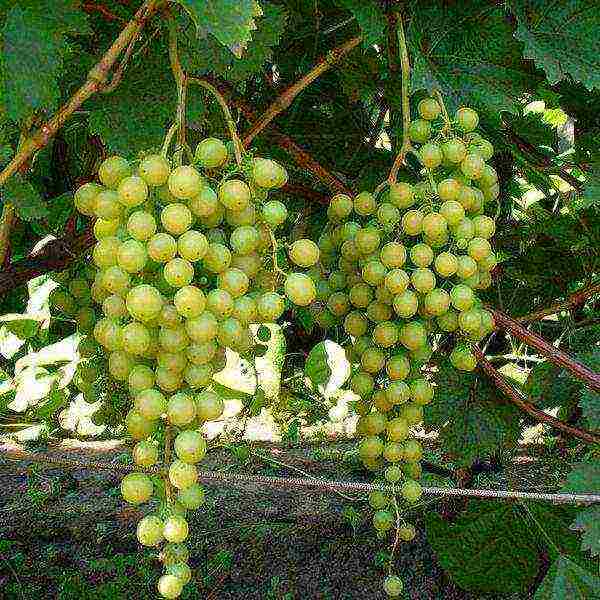
Under favorable conditions, the weight of Tukai berries can reach 4 grams.
Tukai is not highly winter-hardy. His vine can die at temperatures below -25 ° C, and according to some reports, even below -21 ° C. Among other disadvantages of this variety, Belarusian winegrowers note:
- lack of immunity to mildew and powdery mildew;
- frequent problems with pollination in adverse weather conditions;
- tendency to peel berries.
Despite all the problems with pollination, Tukai has matured and almost all is eaten. The taste is strong muscat. Invisible eaten bones. I left a couple of bunches to weigh .. I wonder how much they will pull ???
Late
Grape varieties with a ripening period exceeding 135-140 days are not very suitable for cultivation in Belarus. Most of them do not have time to mature in the short Belarusian summer. Only two relatively late varieties are included in the State Register of Breeding Achievements of this country:
- Alpha. Its dark purple berries with slimy pulp, which has a characteristic isabelle taste, ripen 140-145 days after the beginning of the growing season when the sum of active temperatures is above 2800 °. Despite the rather late ripening period, Alpha is very common in Belarus. This became possible due to its amazing unpretentiousness and frost resistance. She perfectly tolerates winter cold without shelter and does not require any special agrotechnical measures in summer. This variety has a good yield. From one hectare of Alfa's plantings, 150-180 centners of berries can be harvested, which are most often used to make wines and compotes.

Alpha variety is often used for gardening gazebos and terraces.
- Taiga emerald. A table variety with light green sweet and sour berries with a strong strawberry aroma. Differs in high resistance to cold resistance (up to -30 ° C) and the presence of immunity to mildew. The yield of the Taiga emerald is 60–80 kg / ha. Despite its table purpose, in Belarus this variety is often used for the industrial production of wines.
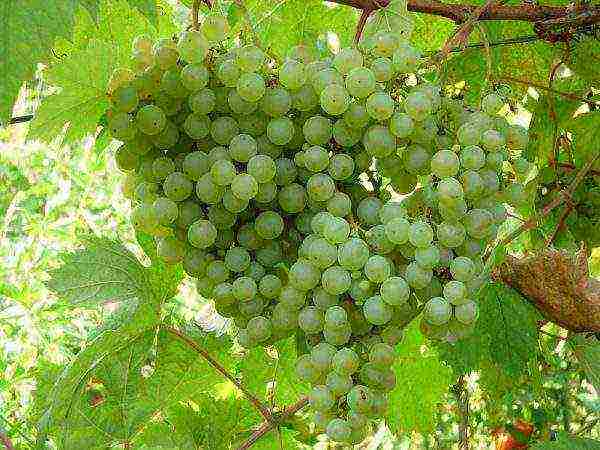
The taiga emerald grape variety was bred by a student of I.V. Michurin Nikolay Tikhonov
I keep a couple of Alpha bushes for compote. I want to try a little to separate it with other varieties when making wine. I just love the taste of Isabella, the taste of childhood, so to speak. There are few people in whom it does not grow. The truth is growing - this is loudly said - no formations, no dressings, no treatments ... .. It survives, but nothing needs to be done .... You don't even need to eat.
Today grapes are not an exotic crop for Belarus. A large number of amateur gardeners grow it on their backyard plots. It is not difficult to become one of them. It is enough to choose a suitable grape variety and pay a little attention to the plant. In return, he will surely thank the novice winegrower with an abundant harvest of sweet and aromatic berries.
Since childhood, I have been fond of growing various plants and have achieved considerable success in this matter. I would be very happy to share my experience.
Very early and early ripening grape varieties. The purpose of the variety is indicated, the bunch and berry, the terms of consumption are described. Advantages and disadvantages of the variety.
Very early grape varieties
- Aleshenkin
- ZILGA
- ASTRONAUT
- SPACE
- CRYSTAL
- MINSK PINK
- NOVOUKRAINSKY EARLY
Early ripening grape varieties
- AGATE DONSKOY
- BIANCA
- BEAUTY OF THE NORTH
- SUPAGA
- TAMBOV WHITE
Loading …
View all polls
Very early grape varieties
Grape varieties.Aleshenkin
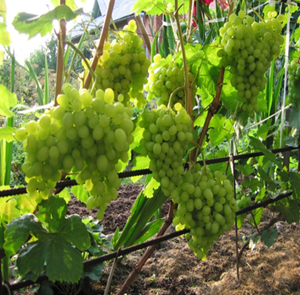 Variety dining room.
Variety dining room.
Peculiarities: the bush has great vigor, the ripening of the shoots is satisfactory. The variety is distinguished by a high fruitfulness of shoots (suicidal variety) - 80%, therefore, it is necessary to carefully carry out green operations: breaking out twin shoots, weak shoots, thinning (1-2 inflorescences are left on a fruitful shoot). One fruitful shoot has an average of 1.8 inflorescences. The load on the bush is 25-35 eyes, pruning - for 4-6 eyes. Bisexual flower
Bunch medium and large, conical and broadly conical, often branched, medium density, weighing 600 g.
Berry medium and large (2.3-3.5 g), oval, matte golden. The pulp is juicy, fleshy, spreading. The taste is sweet, no aroma.
Consumption period: Aug. Sept.
Dignity: The variety is winter-hardy (-26 ° C), high-yielding - 5.5 kg per bush.
Flaw: Resistance to gray rot is average, not resistant to mildew. Requires 3-4 preventive treatments against fungal diseases. The variety is characterized by strong pea berries and requires additional annual pollination.
ZILGA 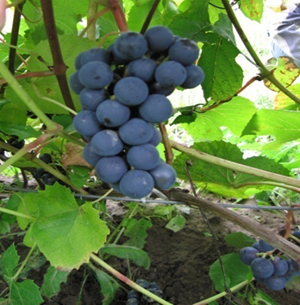
Variety universal. Productivity - 2.5 kg per bush.
Peculiarities: the bush has great vigor, the ripening of the shoots is very good. Fruitful shoots - 78%. On one fruitful shoot, on average, 1.4 inflorescences. The load on the bush is 45-55 eyes, pruning - for 5-7 eyes. The flower is bisexual.
Bunch small and medium, cylindrical with a wing, medium density, weighing 130 g.
Berry medium (2.1 g), oval, blue, with a bluish bloom. The pulp is slimy, sweet and sour with an isable aftertaste.
Consumption period: Aug. Sept.
Dignity: The variety is winter-hardy (-32 ° C), high-yielding - 5.5 kg per bush. Resistant to mildew, gray mold. Requires 1-2 preventive treatments against fungal diseases.
ASTRONAUT 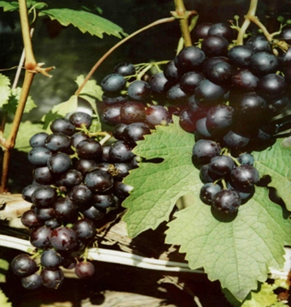
Variety dining room, covering. Productivity - 2.4 kg per bush.
Peculiarities: the bush has great vigor, the ripening of the shoots is good. The load on the bush is 35-45 eyes, pruning - for 4-8 eyes. The flower is bisexual.
Bunch medium and large, branched, loose, weighing 220 g.
Berry medium and large (2.1-2.9 g), round or slightly oval, dark purple. The pulp is fleshy and juicy. The taste is sweet.
Consumption period: Aug. Sept.
Dignity: A variety of increased winter hardiness (-24 ° C).
Flaws: Not resistant to fungal diseases. Requires 3-4 preventive treatments against fungal diseases.
SPACE 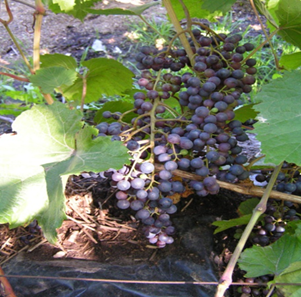
Variety universal, covering. Productivity - 2.1 kg per bush.
Peculiarities: the bush has great vigor, the ripening of the shoots is very good. The flower is bisexual. Fruit-bearing shoots - 57%. One fruitful shoot has an average of 1.3 inflorescences. The load on the bush is 45-55 eyes, pruning is for 6-8 eyes. The flower is bisexual.
Bunch small and medium, branched, loose, weighing 120 g.
Berry small and medium (1.2 g), round, black. The pulp is fleshy and juicy, sweet and sour, rather tart, colored.
Consumption period: September October.
Dignity: A variety of increased winter hardiness (-27 ° C). Resistant to mildew, gray mold. Requires 1-2 preventive treatments against fungal diseases.
CRYSTAL 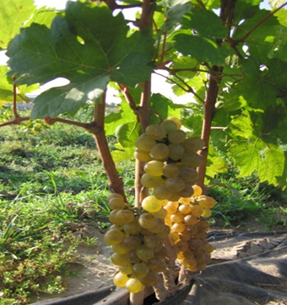
Variety technical.
Peculiarities: the bush has medium and high vigor, the ripening of the shoots is very good. The percentage of fruitful shoots is 85-90. The fertility rate is 1.6. The load on the bush is 40-55 eyes, a short pruning of fruit vines for 3-4 eyes is recommended.
Bunch medium, cylindro-conical, sometimes with developed lobes of medium density, weight 170 g, bisexual flower.
Berry medium (1.5-2.1 g), slightly oval, greenish-yellow, turning pink when ripe on the sunny side, with a purine bloom. The pulp is juicy, the skin is thin, firm, sweet taste. The acidity of the juice decreases very quickly during maturation.
Consumption period: August-October.
Dignity: The variety is winter-hardy (-29 ° C), high-yielding - 3.8 kg per bush. Resistance to fungal diseases is high. Requires 1-2 preventive treatments against fungal diseases. A ripe crop can stay on the bushes for a long time, without being damaged by gray and white rot, without fading.
Flaw: When the canopy of the bush is thickened, the ovary shatters, as a result the clusters become disheveled, the yield decreases.
MINSK PINK 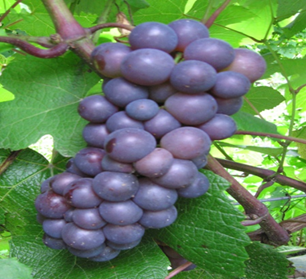
Variety universal purpose, non-covering. Productivity - 3.3 kg per bush.
Peculiarities: the bush has great vigor, the ripening of the shoots is very good. The flower is bisexual. Fruitful shoots - 55%. One fruitful shoot has an average of 1.3 inflorescences. The load on the bush is 45-55 eyes, pruning - for 5-7 eyes. The flower is bisexual.
Bunch medium, cylindrical, medium dense, weighing 160 g.
Berry medium (2.2 g), dark pink. The flesh is slimy, with a pleasant isabelle flavor.
Consumption period: September October.
Dignity: A variety of increased winter hardiness (-29 ° C). Resistant to mildew, gray mold.
Requires 1-2 preventive treatments against fungal diseases.
NOVOUKRAINSKY EARLY
Variety dining room.
Peculiarities: the bush has great vigor, the ripening of the shoots is good. Fruitful shoots - 70%. On one fruitful shoot, on average -
1.5 inflorescences. The load on the bush is 25-35 eyes, pruning - for 4-6 eyes. The flower is bisexual.
Bunch medium, conical, loose, weighing 230 g.
Berry large (3.3 g), rounded, pink, with a strong waxy bloom. The pulp is fleshy and juicy. The taste is sweet, with a pronounced nutmeg aroma.
Consumption period: September October.
Dignity: A variety of increased winter hardiness (-24 ° C). The yield is high - 4.6 kg per bush.
Flaw: Medium resistance to mildew and gray rot. Requires 3-4 preventive treatments against fungal diseases.
Early ripening grape varieties
AGATE DONSKOY
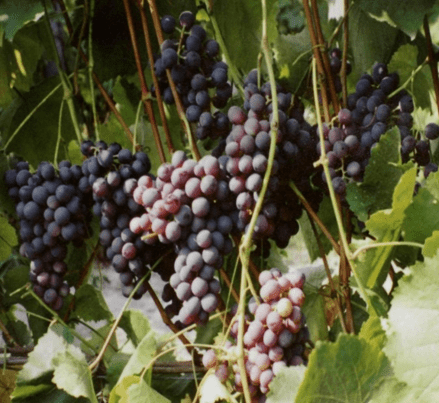 Variety dining room. Transportability is good.
Variety dining room. Transportability is good.
Peculiarities: the bush has great vigor, the ripening of the shoots is good. Fruitful shoots - 75-80%, fruiting coefficient - 1.3-1.5. The load on the bush is 25-35 eyes, pruning - for 5-8 eyes. The flower is bisexual.
Bunch large, conical and broadly conical, medium dense, less often loose, average weight 450 g.
Berry large (4-5 g), round or slightly oval, dark purple. The pulp is fleshy and juicy, the taste is freshly sweet, without aroma.
Consumption period: September October
Dignity: A variety of increased winter hardiness (-26 ° C). The yield is high - 4.8 kg per bush. Resistant to mildew, gray mold. Requires 1-2 preventive treatments against fungal diseases. Stable fruiting.
Flaw: Prone to crop overload. When overloaded, the ripening period is delayed and the quality of the fruit deteriorates.
BIANCA
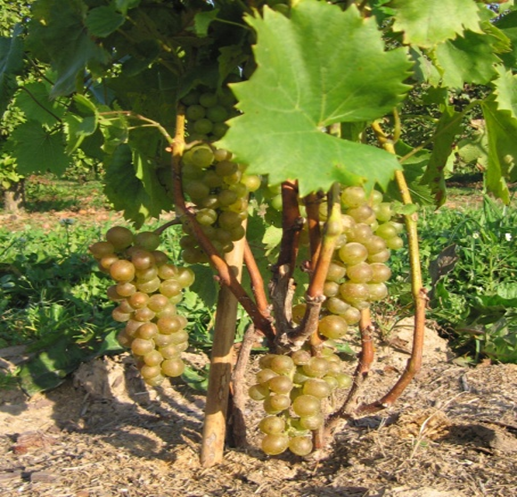 Variety technical. Productivity - 3.5 kg per bush.
Variety technical. Productivity - 3.5 kg per bush.
Peculiarities: the bush has great vigor, the ripening of the shoots is good. The percentage of fruitful shoots is 65-90. The fertility rate is 1.8. The load on the bush is 40-55 eyes, pruning is short or medium, for 4-6 eyes.
Bunch small and medium, cylindro-conical, medium dense, weighing 120 g, bisexual flower.
Berry medium (1.4-1.6 g), round or slightly oval, amber-white. The pulp is juicy, the skin is thin. The taste is sweet and sour with a slight nutmeg aftertaste.
Consumption period: September October.
Dignity: A variety of increased winter hardiness (-26 ° C). Resistant to mildew, gray mold. Requires 1-2 preventive treatments against fungal diseases. The crop is well preserved on the bushes for more than 30 days, does not rot, is not damaged by wasps.
BEAUTY OF THE NORTH
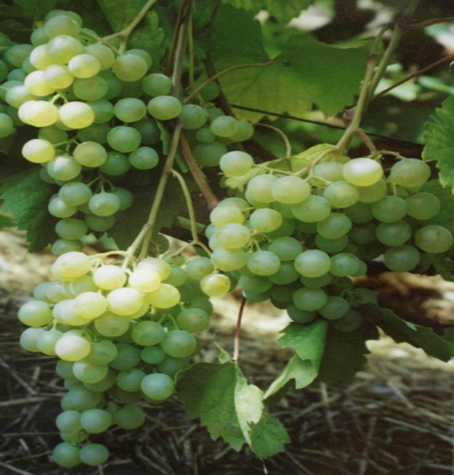 Variety dining room, covering. Transportability is average. Suitable for storage.
Variety dining room, covering. Transportability is average. Suitable for storage.
Peculiarities: vigorous bush. The ripening of the shoots is very good (95%). The uniform is multi-arm, fan-shaped. With a load of 40-45 shoots on the bush and with a length of pruning of fruit vines for 8-10 eyes.
Bunches medium or large (250 g), conical or branched, loose or medium density.
Berries large (4-5 g), round or slightly oval, white, with a pinkish tint on the sunny side. The skin is thin, firm. The pulp is fleshy and juicy, spreading. The taste is pleasant, freshly sweet, with a tart or weak herbaceous aftertaste.
Consumption period: September October.
Dignity: The variety is winter-hardy (-26 ° C). The yield is high - 4.1 kg per bush.
Flaw: Susceptible to mildew and powdery mildew, relatively resistant to gray mold and berry cracking.
SUPAGA

Variety dining room.
Peculiarities: the bush has great vigor, the ripening of the shoots is very good. Fruitful shoots - 80%. On one fruitful shoot, on average, 1.6 inflorescences. The load on the bush is 30-40 eyes, pruning - for 4-6 eyes. The flower is bisexual.
Bunch medium and large, conical, medium density, weighing 260 g.
Berry large (3.4 g), round or slightly oval, greenish-yellow. The pulp is practically not slimy, sweet with a very pleasant unobtrusive isabelle aroma.
Consumption period: September October.
Dignity: The variety is winter-hardy (-30 ° C). The yield is high - 4.1 kg per bush.Resistant to mildew, gray mold. Requires 1-2 preventive treatments against fungal diseases.
TAMBOV WHITE
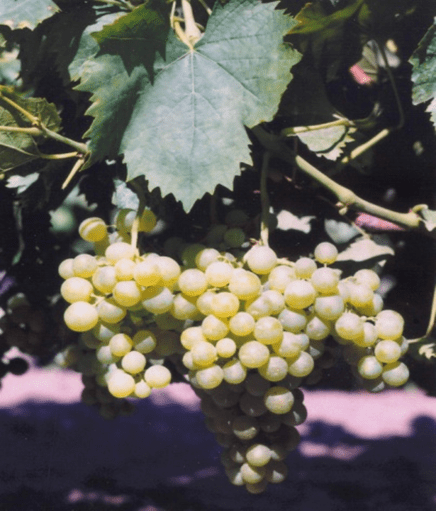 Variety dining room. Average yield - 2.4 kg per bush.
Variety dining room. Average yield - 2.4 kg per bush.
Peculiarities: the bush has great vigor, the ripening of the shoots is good. Fruitful shoots - 80%. On one fruitful shoot, on average, 1.6 inflorescences. The load on the bush is 30-40 eyes, pruning - for 4-6 eyes. The flower is bisexual.
Bunch medium and large, conical, branched, weighing 230 g.
Berry medium (2.3 g), round, white, amber on the sunny side. The pulp is fleshy and juicy. The taste is pleasant, sweet, with a delicate nutmeg aroma.
Consumption period: September October.
Dignity: The variety is winter-hardy (-24 ° C), resistant to gray rot.
Flaw: Not resistant to mildew. Requires 3-4 preventive treatments against fungal diseases.
You can buy grape seedlings and other varieties of fruit and berry crops here:
Material prepared by: gardening specialist Buinovsky O.I.
(Number of views - 3 233, today - 18)
For a long time Belarus was identified with bulba (potato) - the dominant agricultural crop. And the inhabitants of the republic were affectionately nicknamed "Bulbash". Now, in many Belarusian yards, grapes flaunt in a place of honor, organically blending into the local flavor. And now the word "winegrower" is added to the nickname of local residents with good reason.
What influences the choice of grape variety in Belarus
But in fact, grapes in the land of partisan glory look strange - it seems that the weather is not suitable, and the bunches are so luxurious! Let's look at the natural and climatic potential of Belarus and find out which grape variety is capable of bearing fruit here.
Warmly
Grapes are a priori thermophilic plant. For normal vegetation, the formation of ovaries and the accumulation of sugar in the berry, you need warmth. Each region has certain thermal resources that determine the choice of the variety. The average monthly temperature should be +16 ° C. In the north of Belarus, in mid-June and in July, + 26 ... +28 ° C does not happen, so varieties with a high heat demand will not survive. For this reason, the varieties Karaburnu, Original and Original white, Tatiana, Krasa Dona after varietal tests have lost their prospects for Belarus. Varieties with a growing season of 140 days are not suitable even for greenhouses, and for open ground they are not suitable with a period of more than 125 days. In the north, the possibilities of the variety appear only in the seventh year in the open field, and in the fifth in the greenhouse, so there is no need to waste time on dubious experiments.
The southern part of Belarus is best suited for growing grapes. As a result of warming over the past quarter century, the temperature in the country has increased by 1.1 ° C. Because of this, the boundaries of agro-climatic zones "crawled" from north to south. So a new agro-climatic zone appeared within the Brest and Gomel regions, with the warmest weather - the sum of active air temperatures here is more than 2600 ° C (!) - a paradise for mid-season varieties.
The average annual temperature minimum determines the method of growing grapes - covering or non-covering. The required sum of active temperatures for very early grape varieties is 1900–2200 ° C; early - 2200-2400 ° C and mid-early - 2400-2600 ° C.
In order to accumulate and retain precious heat, grapes are planted under the cover of walls of houses or outbuildings, continuous fences from the south and south-west sides.... The peculiar screens also protect the plants from the wind, which disperses the precious heat. As a result, under the wall of the house at any time of the day it is warmer by 1–1.5 ° C, and the sum of active temperatures increases by 200–300 ° C.
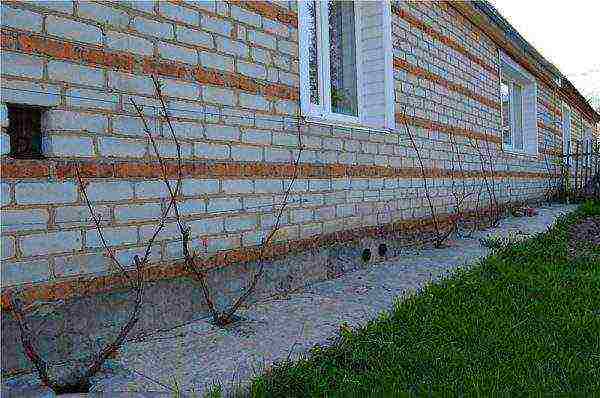
Under the wall of the house and on the south side, the grapes receive a generous portion of sunlight and warmth
Determining the duration of the frost-free period, both spring return frosts and autumn cold snaps are taken into account. For reference, a dormant vine can withstand temperatures as low as -1 ° C, but buds and green shoots die at this temperature. Dormant fruit buds freeze at -5 ... -6 ° C, and swollen buds are contraindicated at temperatures below -2 ... -3 ° C. But in the fall, a drop in temperature to -1 ... -4 ° C does not affect the leaves and ripened shoots of grapes. In the south of Belarus, the frost-free period lasts for 150-180 days, in the north - 140-150. Measures to improve the thermal regime are envisaged already at the stage of planting grapes, and attention is paid to each bush.
Moisture
Grapes are inherently drought-resistant, the roots of an adult plant penetrate deep into the ground and provide it with the necessary amount of moisture. The optimum soil moisture level for grapes should be between 70-80%. But Belarus is located in a zone of sufficient moisture, which exceeds the "grape" norm during the period of prolonged rains. If we add moisture-absorbing soils to this, then the picture emerges is completely disappointing. Excess moisture, undesirable at any time of the growing season, leads to decay of the roots and a delay in the dynamics of plant development.
Rains in the northern viticulture zone significantly reduce the air temperature and increase its humidity up to 100% (the norm for a culture is 60–80%) and is felt physically. Rains during the growing season lead to shedding of flowers and ovaries, and at the end of August they interfere with the process of sugar accumulation, decay of berries, and provoke fungal diseases.
The soil
The main part of the viticulture zone in Belarus is located on sod-podzolic soils, which occupy almost half of the country's territory. They are characterized by increased acidity - pH 3.3–5.5, a thin humus layer and a lack of nitrogen, phosphorus and potassium. Grapes are planted on acidic soils after a number of agrotechnical measures:
- liming - the acidity level is brought to neutral (pH 6.0-6.7);
- the introduction of mineral and organic fertilizers to increase the thickness of the humus layer;
- drainage of the soil (if necessary).
Best of all in Belarus, grapes grow on cultivated loams. Since loams are characterized by light colors, they are "diluted" with peat crumb in large quantities, because dark soil warms up faster than light soil. Such an original method of increasing the thermal regime in the Belarusian style.
Plantage
The quality of soddy-podzolic soils is also improved with the help of plantation, the essence of which is to move the soil layers - the upper fertile down, and the lower infertile up. In Belarus, the average plantation depth is 60–70 cm, so that the roots of the grapes are in a well-heated and fertile soil layer. Plantage in the fall, and in the spring the beds or pits are filled with fertile soil.
Before the plantation on the site, a strip is marked out for the future grape garden, marking the planting sites of the bushes with the help of stakes and ropes. The depth of the future pit will be 70 cm with an area of 100 x 100 m.
At the first pit, the top layer of soil is removed, setting it aside. The middle and bottom layers are also folded separately.
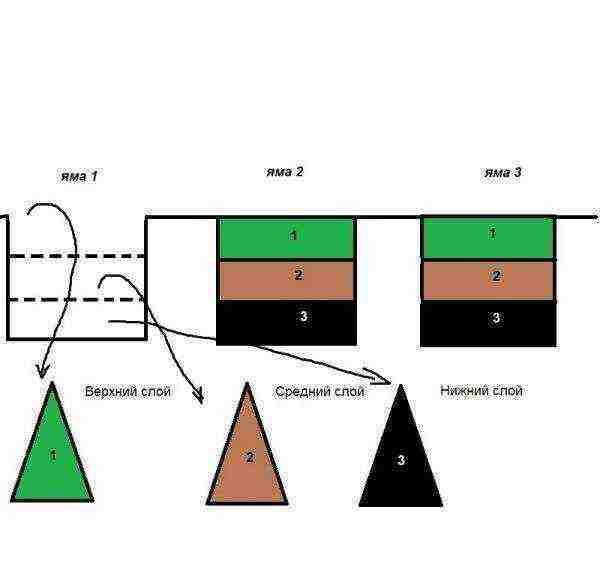
The upper, middle and lower soil layer from the first pit is laid out in separate piles
Remove the fertile layer from the second pit and immediately drop it to the bottom of the first pit. Then the middle layer returns to the same place, and then the lower layer of earth from the first pit, which were deposited in different directions. The first pit is full.
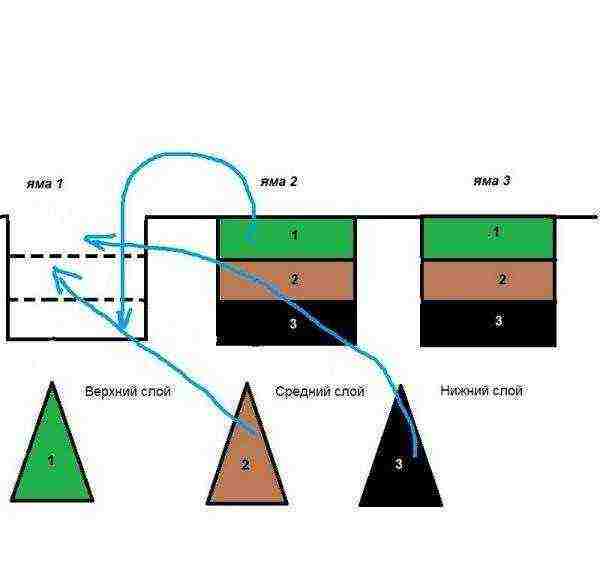
The top layer of soil from the second pit is thrown off to the bottom of the first and the middle and bottom layers are returned to their place
The middle and bottom layers are removed from the second pit, laying them in different directions.
They begin to dig the third hole, dropping the upper horizon of fertile soil into the second hole and filling it with the middle and then the lower layer removed earlier.

The first pit is ready, the middle and bottom portions of the soil from the second pit have been set aside.The upper horizon from the third pit is dropped to the bottom of the second, etc. according to the previous scenario
At first glance, you can get confused, but in practice everything is very clear. Each time the fertile horizon from the next pit is dropped to the bottom of the previous one and it is filled with “native” soil - first with the lower, and then with the middle layer. In fact, the middle layer of the earth remains in place, only the upper and lower horizons change in places. When plantation is carried out in strips, trenches are dug along the width of the strip, the "cycle" of the earth remains the same.
Planting northern grapes
When planting grapes, there are two purposes - to accumulate heat and prevent root rot.
Autumn arrangement of the landing pit:
- They dig a trench 0.8-1.0 m deep and 1 m wide. If a row of grape bushes is planted, the length of the ditch is calculated based on the distance between the bushes - 0.75-1.1 m. The fertile soil is folded separately.
- On sandy soil with a groundwater height of more than 2.5 m, the bottom is compacted with soft clay.
- A layer of construction debris, plant residues, semi-rotted manure is poured.
- The previously deposited soil is mixed with clay, drainage (pebbles, broken brick) and humus, taken in equal parts. For each running meter of the trench, double superphosphate is added to the resulting substrate - 200 g, meat and bone meal - 1 liter, wood ash - 2 liters. Spread the prepared soil over the plant residues so that about 0.5-0.6 m remains to the edge of the trench.
- Large stones are stacked mixed with rubble in a layer 15–20 cm thick.
- A plastic tube 3-5 cm in diameter is inserted into the stones at an angle; this is a probe through which the grapes will be fed and watered. The end of the tube is placed under the roots.
- Coarse sand is poured with a layer of 15–20 cm.
- The rest of the soil with fertilizers is poured on top. You should get a ridge with a height of about 20-30 cm.
- The prepared trench is left until spring to settle.
- In the spring, they fill up the soil to make a ridge 20 cm high.

The planting trench for Belarusian grapes has a thoroughly insulated bottom
Plants are planted to a depth of 25-30 cm, this is how the soil warms up in the northern regions of Belarus. The upper trellis is made rigid, it will serve as the basis for a temporary greenhouse during recurrent frosts.
If the garden for grapes is not prepared, and the seedling is purchased, it is left to grow in a plastic bag with a volume of 10 liters. Why not in a bucket? It is easier to transplant from the package to a permanent place, it is enough to cut it from the bottom and lower it into the pit. The package is removed through the "head". So the earthy ball is not destroyed, the roots are preserved intact and the seedling does not experience stress.
Top dressing
Nitrogen, phosphorus and potassium are the three fundamental ones, without which the normal development of the grape bush and the formation of a full-fledged bunch are impossible. Nitrogen requires special care in its use. It is indispensable during the active growth of shoots, leaves, antennae and bud formation.
An excess of phosphorus in the soil leads to fattening of the bush: juicy green leaves flaunt on the grapes until autumn, the shoots do not ripen (they remain green, although they should turn brown). The berries of the fatty bush are tasteless, watery and prone to decay.
Phosphorus is responsible for the development of the formation of the ovary, the ripening of the bunches and the ripening of the shoots. Potassium also contributes to the ripening of shoots and, most importantly, the accumulation of sugar in the berries.
Grapes under the age of three years inclusive are fed three times a year:
- When shoots begin to develop. Use nitrogen-phosphorus-potassium fertilizers or liquid organic matter.
- After 20-30 days, using a similar composition.
- When the shoots begin to ripen - this is about the end of July, nitrogen is excluded from the top dressing.
For foliar spraying, it is convenient to use complex micronutrient fertilizers (Mik, Nutrivant Plus, Green Guy). Fertilizers of a new generation - Master (Italy) and Kristalon (Holland) - have become popular for root dressing in Belarus.Not for advertising - Crystalon is very convenient to use for both a specialist and a novice winegrower. Depending on the lack of nutrients or the stage of development of the grapes, a package with a pattern of a certain color is chosen. For example, blue denotes increased nitrogen + potassium and is used early and before flowering, while red packaging denotes increased potassium and is used during flowering and fruiting.
Fight against fungal diseases
The cool climate of Belarus becomes a real paradise for mildew or downy mildew - a fungal disease of grapes. The spores of the fungus are activated before or during flowering, covering the inside of the leaf with a white coating and showing through with pale yellow spots from the front.
Another enemy of grapes is powdery mildew, which appears at + 20 ... + 25 ° C. Such temperatures are not typical for southern regions, which cannot be said about Belarus. Oidium appears as a gray coating on the upper side of the leaves, gradually covering the entire plant.
Gray and black rot are faithful "friends" of prolonged wet weather. When infected, berries are mostly affected, with gray rot affecting ripening ones, and black rot affecting green grapes.
Prevention of fungal diseases includes:
- cultivation of zoned varieties;
- spraying, feeding is carried out in the morning or evening hours;
- non-thickened plantings;
- jet watering, without spraying the leaves;
- green operations - pinching, pinching the tops of shoots, breaking out;
- the use of balanced fertilizers so as not to overfeed the bushes.
Biological means of prevention and protection against fungal diseases will be biological products Baikal M-1, Valagro, Albit, Novosil. Good results are obtained by prophylactic spraying of bushes with 10% milk whey. Processing is carried out in the period from the end of peeling to the beginning of ripening twice or three times with a week break.
The use of chemical preparations begins when the temperature rises to + 10 ... + 13 ° C and ends a month or a month and a half before harvesting (depending on the waiting period for a particular preparation).
- Copper or iron vitriol in a concentration of 3-5% (depending on the age of the bush) - carry out spring spraying before bud break or autumn after harvesting.
- Bordeaux liquid - spraying before and after flowering, as well as before ripening. After rain, the treatment is repeated.
- Shavit, Ridomil Gold - complex preparations for several rot. Processing is carried out before flowering.
Agrotechnical techniques
Of the many types of forming grape bushes in the northern part of Belarus, it is worth highlighting the capitate forming. Its essence lies in the fact that the fruit shoot is laid in an arc on the upper trellis, and the green shoots with bunches are not tied up, but hang freely. Due to the fact that they are directed not up, but down, their growth is naturally limited, and this minimizes the number of green transactions.
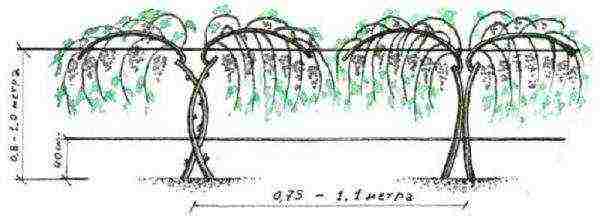
The capitate shape of the bush allows the green shoots to hang down, which is why the bush does not grow much
Prune the vine in late October - early November. The grapes are propagated by rooting lignified cuttings with growing in plastic sleeves.
How to send grapes to winter
For the winter, grapes are covered when the cold snap becomes stable. The vines are bent to the ground, tied up and covered with heat-insulating material (spruce branches, dry non-caking grass). Rye straw is a good covering material; mice do not favor it. Under any shelter, you can spread the poison for rodents, and remove its remnants in the spring.
From above, they arrange an impromptu hut made of the same spruce branches, wooden shields for the entire width of the garden, cover them with polyethylene and fix them with something heavy. The ends of the "tunnel" are left open until severe frosts - freely circulating air will not allow condensate to accumulate... If there is no dampness in the shelter, and if it is covered with snow from above, the grapes will survive any frost.
Photo gallery: types of winter shelters of grapes for the winter
How to open grapes in spring
In the spring, the insulation is checked for dampness and is not removed until the return frosts have passed. At the same time, the ends are left open, in such conditions, buds may even wake up on the grapes and shoots appear. In this case, the insulation is removed gradually, because the grape shoots are extremely fragile, and the broken shoot will expire with juice.
When it gets warmer up to + 15… + 20 ° C during the day, and at night + 3… + 5 ° C, the upper shelter is turned to one side in order to exclude the appearance of the greenhouse effect. For two days the vine “breathes” fresh air and dries up, after which a prophylactic spraying of 3% Azophos is carried out to disinfect its surface. Then, water-charging irrigation is carried out, spending 20-30 liters of water under one bush.
It is not yet possible to fully open the grapes, because recurrent frosts are not excluded. For example, in 2017 there was a sharp drop in temperature to -7 ° C. It’s scary to imagine how many bushes opened before the deadline froze! But it is also impossible not to open the shelter, because the temperature under it rises and grape tops - the buds can start to grow. Since the earth has not yet warmed up, the roots of the grapes are still sleeping, and the buds will live on the internal reserves of the cuttings. When nutrients are depleted, the kidneys tend to dry out.
Which variety to choose
Each person approaches the choice of a variety for different reasons. Any attempt at classification will result in the same varieties being repeated in one category or another. And for the inexperienced wine grower, we will only hint what you should pay attention to when choosing a variety.
Frost-resistant grape varieties
If you choose a super-frost-resistant variety, you should pay attention to the following:
- Juodupe has a vegetative period of 100–110 days, it can withstand temperatures as low as -30 ° C, and if in the north of Belarus it is only bent down or a light shelter is made, in the southern regions of the country it hibernates on a trellis. Juodupe berries are blue, the skin is almost invisible when eaten, they have a barely noticeable strawberry aroma;
- Sharov's Riddle is an early variety that ripens regardless of weather conditions. The berries seem gray from a thick bloom of pruin (wax bloom), have a fickle taste in a good way - either strawberry or some other. The mass of the bunch reaches up to half a kilogram. Frost resistance up to -32 ° C allows the bush to winter under the snow;
- New Russian - the variety can withstand temperatures down to -28 ... -30 ° C, the berries are dark pink, weighing an average of 5 g, are prone to cracking;
- Swenson Red is the record holder for frost resistance - down to -34 ° C. The bunch weighs from 300 to 500 g, in the north it ripens in the second decade of September. Berries to taste belong to the same "strawberry series", the wine from Svenson Red has an amazing aroma. The variety is resistant to fungal diseases. The female type of flower requires a pollinator. In some years it is prone to peas.
Photo gallery: super-frost-resistant varieties
Very early grapes
- Liepajas Dzintars - the vegetative period lasts only 90-100 days, therefore it belongs to the very early varieties. Ripens in mid-August. Amber clusters are small - up to 300 g, but very sweet, smell like nutmeg. The variety is frost and disease resistant;
- Makdalsky - ripens 15 days later, but also larger clusters - up to half a kilogram. The berries also smell like nutmeg, very sweet, resistant to cracking. The variety is distinguished by the full maturation of the vine. They cover for the winter.
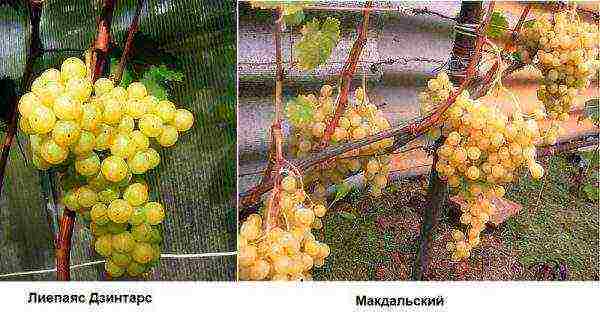
Already in August, you can enjoy the taste of Liepajas Dzintars and Makdalski grapes
Seedless varieties
- Radiant kishmish - has clusters weighing up to 1 kg, in the northern regions it begins to ripen from early to mid-September. The berries are pink-red in color with firm pulp and nutmeg aroma. Susceptible to fungal diseases;
- Kishmish 342 (Hungarian selection) is a vigorous variety with a vegetative period of 110–115 days. The berries are white, fleshy and sweet;
- In memory of Dombkovskaya - a variety with medium-sized bunches weighing an average of 370 g. It has remarkable properties: it is maximally resistant to diseases and pests, one-year growth always ripens, therefore, it tolerates wintering well. The berries are black and the juice is deep pink. The recommended load on the bush is 40-50 eyes.
Photo gallery: raisins for Belarus
Open field grapes
- Early northern - recognizable by white berries with a brownish barrel. Fungus resistance is average, requires 3-4 preventive treatments; hibernates under light cover;
- Agate Donskoy - uncovered at a temperature of -26 ° C, the risk of damage is 10–20%. Average berry weight 5 g, each with 2 seeds;
- Adel - the variety can withstand frosts down to -30 ° C, overwinters under spruce branches; in case of freezing, it recovers well. Medium resistant to fungus; berries do not crumble. Aging does not depend on weather conditions;
- Rusbol is resistant to powdery mildew and mildew, therefore the treatments are of a preventive nature. The average weight of a bunch is 500 g, the maximum weight is 1 kg. The berries are white with a brownish barrel, without seeds. The variety is used as a pollinator.
Photo gallery: grape varieties for open ground
Varieties with large clusters
The varieties that form huge clusters do not seem to have the strength to fight disease and frost. Such grapes require timely antifungal measures, they work well in unheated greenhouses, where they are covered with special care for the winter.
- Aleshenkin (Volgograd selection) - demanding of heat (the required sum of temperatures is 2000 ° C), vigorous. Berries without seeds are often found, although the variety does not belong to the type of raisins. Bunch weight from 1 to 2 kg;
- Veles (amateur selection of V.V. Zagorulko, Ukraine) - vegetative period from 95 to 100 days, vigorous. Forms giant clusters weighing up to 2 kg. The berries are dark pink, the skin is thin, not felt when eating, the taste is nutmeg.
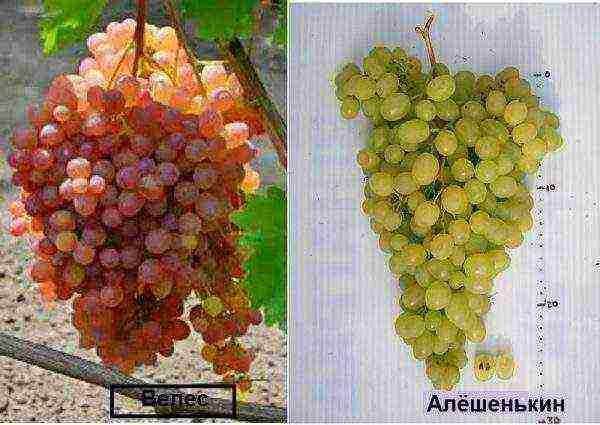
Varieties with huge bunches require special care
Wall culture
Such varieties adore warm ground, are extremely sensitive to cool breezes. Under the protection of the wall, they reach their full potential. The frost resistance of such grapes ranges from -21 ... -25 ° C, therefore, they are thoroughly covered for the winter.
- Pretty woman - the average weight of a bunch reaches 500 g, the berries are very beautiful - pink, oblong; with drops in moisture, the soil can crack;
- Arcadia - especially sensitive to powdery mildew; has large clusters - up to 700 g, berries are white, large, weighing 7-14 g, fleshy, with a nutmeg aroma. Seedlings of Arcadia take root well and begin to bear fruit early; the vine ripens well.
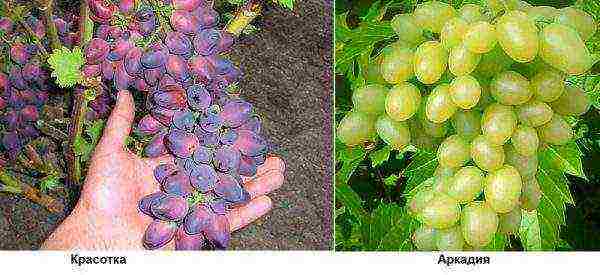
Wall grapes - sissy and "capricious", but beautiful and tasty
Varieties for unheated greenhouses
- Kodryanka is a vigorous bush; elongated berries are almost black in color with the same dark fleshy pulp, have 1-2 seeds, but they are soft, so the grapes are suitable for drying. Transportable;
- Victor - can also be grown in wall culture. Large pink-red berries (10-14 g) are folded into a large bunch weighing up to 800 g. Resistant to fungus, control measures are reduced to preventive treatments;
- Kishmish Zaporozhye - vegetation period 110–120 days; well resistant to fungus. The maximum weight of a bunch is 900 g, the berries are colored in dark tones of red or purple; it is recommended to pinch the ends of the inflorescences for full maturation of the brush.
Photo gallery: grape varieties for unheated greenhouses
Video: an overview of grape varieties from an amateur winegrower
Superearly, early and mid-early grape varieties are recognized as profitable for Belarus. The culture is grown in non-sheltered greenhouses or in the open field as a wall culture. Late ripening varieties do not ripen in local climatic conditions.

